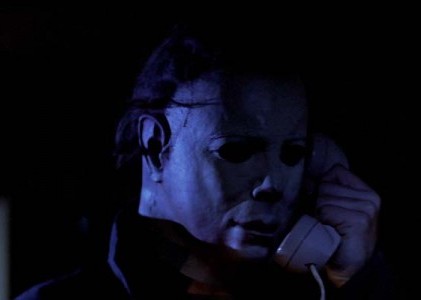The Movie Monk
This article is published in conjunction with a screening of Halloween at Museum of the Moving Image on Friday, October 25, 2013, introduced by Nick Pinkerton. The screening is part of the ongoing series See it Big.
Tom Allen was one of the first New York critics to give serious consideration to the work of John Waters, George A. Romero, Clint Eastwood, and John Carpenter. He was a contributor to The Soho Weekly News, The Village Voice, Film Comment, and The Long Island Catholic. He was an acolyte, amanuensis, and all-around right-hand-man to Andrew Sarris, and later an an advisor to Romero. And though he defended culturally suspect and sometimes downright scurrilous films in downtown, left-wing papers, where his work appeared alongside advertisements for the Ramrod Male Theatre and Masters & Johnson Sex Therapy, Tom Allen was also a monk.
Of Waters' Desperate Living, Allen wrote that "[b]eneath the sleaze and the uniformly hysterical pitch of the acting, Waters is an austerely economical director who is figuratively comparable to Bresson. He is a driven, integral stylist. His troupe are beautiful ogres because they collaborate in absolute harmony with his ends, and are, therefore, not exploited." Reviewing Martin, Allen wrote that "Romero remains an outstanding gothic original, the best of our regional naturals... With semi-pro actors and local crews, he conveys his one-track manias as fluidly as Buñuel in Mexico . . . there is an exhilarating freshness in his work, and a constant feeling of surprise around the corner." As Allen's Voice colleague J. Hoberman notes in a recent memoir piece for Film Comment, he "hit the ball out of the park as Carpenter's earliest champion," having given Halloween a crucial New York rave. And after cautiously circling Eastwood's "exciting . . . frustrating" career through the ‘70s, Allen opens a review of his 1980 story of an itinerant, modern-day Wild West show, simply: "Bless you, Bronco Billy."
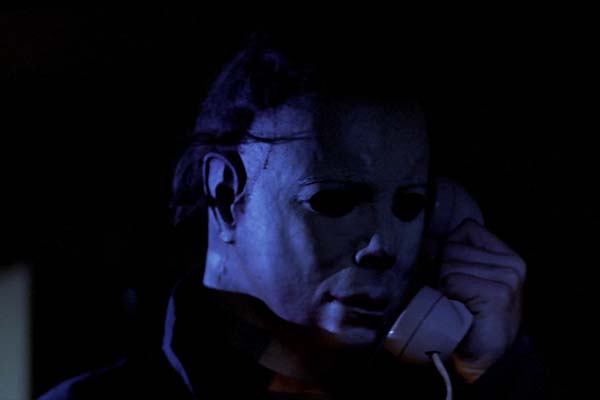
Allen on Halloween: "a study in warm colors, dark shadows, and ceaselessly tracking dollies [which] owes more to the expressive possibilities raised by Vincente Minnelli in the Halloween sequence of Meet Me in St. Louis than to any films in the realistic school."
Despite these scoops, Allen is today a somewhat forgotten figure. In The Village Voice Film Guide, published in 2007, he is represented by three perspicacious pieces, on Halloween, Shohei Imamura's Vengeance Is Mine, and Ousmane Sembène's Ceddo. Yet Allen's life and work reward looking at in greater depth not only because he was one of cinema's assiduous toilers (there are many of these) or because he was a smart, original writer (these are somewhat rarer), but because he provides a particular case study in the auteurist faith which is still with us today, and because, living and writing through an often lackluster period of American movies made by "ex-talent agents, tax-shelter seekers, and procurers of international backing," he found examples of the cooperative to extol against the corporate.
Where did Tom Allen, who batted in the two-hole of a Murderer's Row lineup between Sarris and Hoberman, go? Better first to try to figure out where he came from. We have some clues as to Brother Allen's provenance. He was certainly born in 1938. He called Lords of Flatbush "an Avenue J film that this son of Avenue I found as ridiculously phony as native Indians must have found the Italian Apaches in Republic Westerns," which makes him a Flatbush native. Hoberman accordingly recalls that Allen, like he and Sarris, was born in Brooklyn. Kent Jones, a former Village Voice intern who counts Allen as a professional mentor, and who is now Director of Programming for the New York Film Festival, recalls that Allen hailed from Metuchen, New Jersey.
In fact, Metuchen is where Allen was reborn as Brother Tom, taking his Profession of Vows at that city's St. Joseph's Juniorate and Novitiate. Brother Joe Murphy, who spoke to me about Allen, was in the same class as the man who he called "Tommy" from first grade through undergraduate. Recently retired from a life's teaching and living in Hartsdale, New York, Murphy first met Allen when they were both attending St. Rose of Lima, a parochial school in the Parkville section of Brooklyn, near Ocean Parkway. He knew Allen's blue-collar Irish-American family, and remembers their breezy humor: "You'd sit down at the dinner table and it was all fast one-liners, very funny, both father and mother throwing zingers back and forth." In 1952, Murphy and Allen entered St. Joseph's together, with the intention of joining the Order of the Brothers of the Sacred Heart.
The congregation of the Brothers of the Sacred Heart was founded in 1821 in the Diocese of Lyons, France, by Père André Coindre. Its Constitutions are Jesuit, while its Rule of Life is that of St. Augustine; along with chastity, poverty, and charity, it places emphasis on the necessity of labor. The vast majority of the congregation are lay brothers, and their mission, undertaken with the intent of enacting a moral regeneration in a nation traumatized by the Reign of Terror and Napoleonic Wars, is the Christian education of the young. The first Brothers to arrive in North America set up shop in Mobile, Alabama, in January 1847, and the order spread far and wide from there.
In 1902, Brothers Stanislaus Florent and Louis Fabian moved into a property in Metuchen which became the site of Saint Joseph's House of Studies. It still stands in Middlesex Country. Behind a statue of St. Francis, a chapel and residence hall flank a charming four-storied wood main house with a vestigial Victorian character. All of this is adjacent to St. Joseph's High School, which has been staffed by the Brothers since opening in 1961. This land held a vineyard when Allen and Murphy were here, and the Brothers grew "horse corn" on the present-day athletic fields. From the Houe of Studies it's a short walk to the Francis of Assisi Cathedral, a bulky stone structure which would've been a wood church in the fifties, or to the Forum Theatre on Main Street, which has looked much the same since 1928. Allen watched every movie on TV at St. Joseph's, and Murphy remembers him keeping boxes of index cards with details on cast and crew, as well as his comments.
Allen and Murphy both entered Spring Hill College, a Jesuit institution outside of Mobile, in 1957. Spring Hill was the first desegregated Southern university since Reconstruction, and there was tension between the locals and the student body, largely made of transplants from New York and New Jersey. Murphy recalls an incident that nearly turned ugly when, riding the bus in the city, Tommy drew the ire of white riders by obliviously sitting in the back, behind a black man. There were rumors of the Ku Klux Klan burning crosses in front of the campus on Friday nights—"Southerners who were drunk and were mad about us coming down and disrespecting their traditions. They didn't have enough numbers or the guts to stay. There were plenty of us who would have just as soon had a fight as to go study."
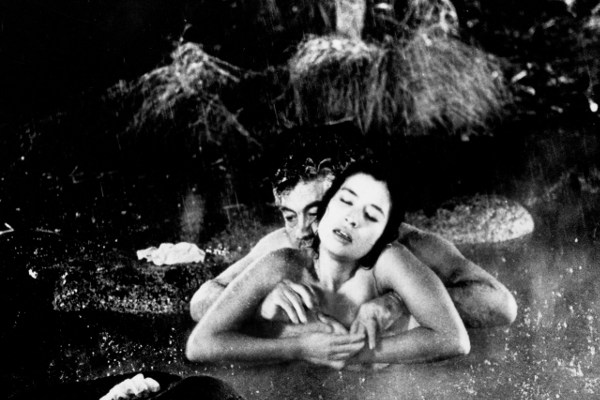
Allen on Vengeance Is Mine: "An eclectically horrifying mosaic about a psychopathic criminal named Iwao Enokizu...a mystery play that is both compelling and repelling...At least half a dozen characters, including father, wife, mistress, and victims—all of whom share sophisticated and emotive interlocking relationships—chip away at Iwao's veneer but come away with only pieces of the mystery."
Upon returning to New York, Allen fulfilled his mission by living and teaching at Bishop Edmund J. Reilley Diocesan high school (now St. Francis Preparatory High School) in Fresh Meadows, Queens. Murphy, who joined him there, describes Allen as "A very laid-back teacher; I never saw him irritated." After studying theology at Fordham for a time, Allen moved into the graduate program at Columbia University, where he was taught by Arthur Barron. It was evidently there that he became an acolyte of Andrew Sarris, then lecturing at Columbia, and a convert to Sarris's particular American strain of auteurism.
Murphy thinks that Sarris may have been instrumental in awarding Allen a scholarship. Whatever the case, Allen's tastes were by then somewhat at odds with those of his co-workers at Bishop Reilly. "It would be the weekend, and somebody at school would ask, ‘Tommy, what's a good movie?' And he'd make his recommendation, and they'd come back, ‘That was the worst movie I ever saw.' He'd say ‘But what about the lighting?', they'd say, ‘Lighting? I don't need to know about the lighting. I was looking for a good show with cops and robbers!' These were regular people from New York City."
We first draw a bead on Allen the journalist at the SoHo Weekly News, founded in 1973, and the Voice's principal competition as a downtown news sheet. After being disinvited from the Voice in one of the paper's already customary bloodbaths, Jonas Mekas had taken his "Movie Journal" to the SoHo Weekly. Daryl Chin, today a multimedia artist, critic, and curator, joined the paper as an adjunct to Mekas, and there met the film editor, Tom Allen, already an established figure in the New York cinephile scene by 1975. Chin says his new editor "was amused at how I could bring in references to Michael Fried, conceptual art, and Doris Day, all in one paragraph." Allen himself excelled at this sort of free-association; reviewing Moonraker, he marvels that "few filmmakers other than Tex Avery and Luis Buñuel have more audaciously explored the dissociative potential of film editing than the present Bond team."
From the SoHo Weekly, Allen migrated to join Sarris at the Voice. I first encountered his byline some time ago in the archives of that paper, to which I contributed over the course of five-and-a-half years within the New Times/ Voice Media Group era—from 2007 to early 2013, in the transition from decadence to extreme putrescence. On occasional visits to the stacks, when looking for reviews of certain lowbrow properties of the late seventies, I would note the name "Tom Allen" attached to sensitive, serious write-ups of movies that The Times' pecksniffish Vincent Canby wouldn't have seen fit to muss his ascot over, movies like Larry Yust's Homebodies ("a sinewy, savvy stepchild of the darker Ladykillers school ...one of the contenders you kick around when drawing up a list of memorable cult movies...") and Defiance by John Flynn, "the vendetta-king of intelligent action." When I found out that, concurrent to his tenure at the Voice, Allen was living with a community of monks in the South Bronx and contributing to a publication called The Long Island Catholic, the hooks were in.
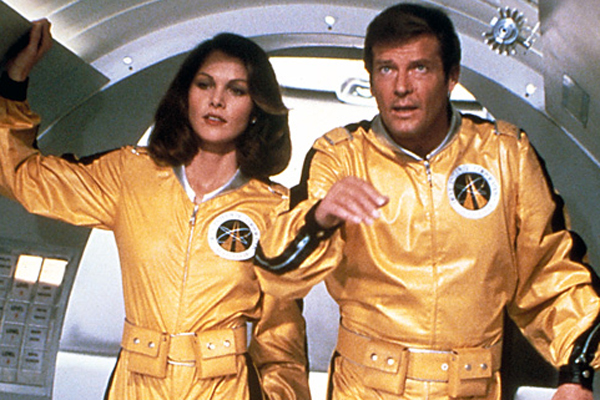
Allen on Moonraker: "...enter the James Bond of Moonraker, a conceit of pure reflex action and the centerpiece symbol of a fully streamlined catalytic formula... it is as stylized as animation, and as choreographed as musical comedy... The people who made this impudent, wry, and exhilarating movie completely left out the '70s and its predominating motif of realism. Moonraker is the most expensive avant-garde movie since Barry Lyndon."
That Allen was a self-styled connoisseur of movies orphaned by the critical establishment is clear in a 1977 review roundup titled "Adventures on the Sleaze Patrol," which begins: "The garbage detail is a critical beat that includes porn, kung fu, blaxploitation, children's matinee, spaghetti western, Tokyo monster, and other ignored sub-genre movies... The pile grows and the rare find gets buried deeper. Yearly, it becomes increasingly difficult to fulfill the nethermost imperative of the critic: to distinguish authentic bad taste from exploitation." Later, championing the "tremendous amount of vitality in films opening far from the Bloomingdale's belt," Allen pillories the John Simon/Dwight MacDonald ideal of reviewing only "important" movies while leaving stringers to gnaw on the leftovers, of dwelling in "an ivory tower erected far above the asphalt beat." "That's really a manifesto that he wrote there," Hoberman says of "Sleaze Patrol." "Andy [Sarris] could've cared care less about that kind of stuff." Jones remembers first noticing Allen's work around this time, when he was talking seriously about "stuff like Assault on Precinct 13."
"There are others who relish [B-movies] for their kinks and obsessions as a radicalizing force," Allen writes, "Personally, I usually junk the script and savor the grace moments." He found those grace moments in the unlikeliest places. Among Allen's happily expressed enthusiasms: the films of Shunya Ito, Flynn's Rolling Thunder, Burt Reynolds's Gator, Cornel Wilde's Sharks' Treasure, L.Q. Jones's A Boy and His Dog, Renee Daalder's Massacre at Central High, James Frawley's The Big Bus, Arthur Ripley's Thunder Road, Richard Sarafian's Vanishing Point, George Miller's The Road Warrior, and Peter Hyams's Busting.
Lest I paint a picture of a mad monk roaming between fleapit theaters on the Deuce with a beatific grin and a stained habit, it should be noted that Allen was equally adept in elucidating the merits and demerits of official film artists, though he treated them with no categorical difference. Allen did some of his strongest work on known quantities like Ichikawa, Ettore Scola, Elio Petri, Mizoguchi, and Roberto Rossellini—reviewing the latter's Blaise Pascal, he describes star Pierre Arditi as combining "a pop star's hairdo and amphetamine intensity with the stooped posture and introverted wryness of a high school creep." He also scoured the horizon for incoming talents from abroad—Chin remembers he was especially interested in "the emergence of new filmmakers from Asia"—and was an early stateside champion of Imamura, Peter Weir, and Alan Clarke, whose Scum, he writes, is "a bar-rattling exposé of Britain's Borstal system for youthful offenders . . . constructed with the inevitability of a time bomb."
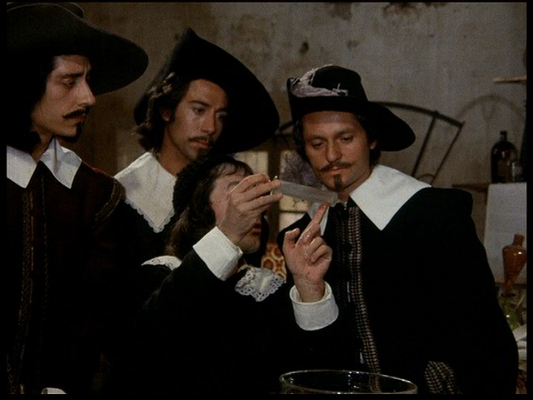
Allen on Blaise Pascal: "Its icy, apparently objective surface is laced with the dazzling footwork of Pascal's logical arabesques. But underneath swims a school of odd obsessions... At muddy bottom, Rossellini suggests, there lies a Freudian tangle involving Pascal, his father, and his deeply religious sister."
Allen was equally at home with lightweight Champs-Élysées French farces and TV movies, of which he was an eager student, working references to Curtis Harrington's Killer Bees, Michael Miller's Outside Chance ("the first of Roger Corman's New World telefilms on CBS"), and George Cukor's The Corn Is Green into the Voice. He even contributed a piece to Film Comment on "The Semi-Precious Age of TV Movies" ("It is impossible to imagine any body of film more maligned by cineastes..."), and another on the vital early years of Disney, having elsewhere called animation "the richest, most demanding form of film." (His first piece as the Voice's official second-stringer covers a smutty toon called Dirty Duck and Disney's The Rescuers.) Best to say of Allen, as he once said of Richard Fleischer (though not quite as a compliment), that he had "frighteningly catholic tastes."
Allen was also a large-C Catholic, which interfaced in interesting ways with his film love. Jones identifies Allen as a "self-conscious upholder of the auteurist faith. I think meeting him was the first experience I'd had of auteurism as an article of faith, as something to be defended. It was a bit odd." Molly Haskell, critic, author, and Sarris's widow, concurs: "That was his mission. He and Andrew were both missionaries of a sort. There was nothing overtly religious in Andrew, but he always had said that Christianity was so much a part of him, and his Christianity shaped his taste in film so much more than the Marxism of many left-leaning critics. And in some sense Tom echoed this spiritual side of Andrew." Says Jones "The equation of auteurism and Christianity, or the alignment of them, was nothing he would have articulated, but it was definitely something that was present for him."
Once aware that Allen was a monk, one can't help but scan his work for "traces." Allen objects to nothing in Hal Ashby's Being There except Peter Sellers' Chance walking on water at the end. He cites the Taviani brothers' Padre Padrone as his favorite film of 1977, "because it most vividly evoked the frissons of discovering cinema afresh both as an art form and a humanistic experience. You might say, literally, it rang them chimes." Sembene's Ceddo, he writes, "has the deceptive simplicity of a medieval morality play." Even Dawn of the Dead is, for Allen, "a wildly fantastic morality tale [woven] against a seductive canvas of American materialism," with "real contemporary heroes grappling with vices and virtues . . . " By contrast, reviewing Richard Marquand's black-magic turkey The Legacy in a piece titled "The Venality of Evil," Allen writes that "the trivializing of evil into alternative kinks for jaded contemporaries is one of the worst recent developments within the traditional horror genre." For Allen, evil was serious business-and horror a sort of moral crucible. When pleased, Allen would indulge in occasional benedictions, as in that Bronco Billy lede. Ending a review of a film opening at Cinema Studio, Allen pauses to note that this is the theater "where paying customers, bless them, have just supported Chaplin's silent A Woman of Paris for an amazing six-week run. Miracles can happen."
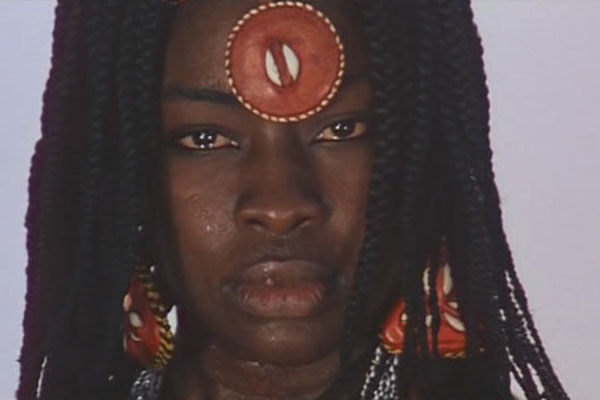
Allen on Ceddo: "Sembene's cinema is cast in pageant form, in which the raw forces of culture, politics, and religion clash on an uncluttered stage. It is a form of public, primal art, pre-dating the psychological concerns and the self-involvement that has so preoccupied modern Western civilization. Sembene's manner resembles that of Euripides who, while working far outside his character projections, invited the audience to delve deeply into the forces at work in the country."
Much of this is hardly unique to a man of the cloth, while it needs be said that la politiques des auteurs, in its original French form, was in large part the work of French Catholics reacting to the knee-jerk existential bleakness of their intellectual culture. Allen, says Jones, "had that thing that a lot of auteurists have, where he reacted negatively to elements in movies that were not uplifting, like in Raging Bull." "I never could figure out," Allen writes, "why filmmakers should waste time on despicable characters with absurd motivations in lost causes." Reviewing Henry Jaglom's Tracks, Allen cites its "noncathartic pain as part of the problem in splintering and driving away the audience needed to support new cinema forms." Paul Schrader comes in for particular abuse, singled out as "a flashy wordsmith whose aggressive self-promotion has generated more attention than the quality of his work deserves" and, with brother Leonard, "among the worst influences on contemporary film." (Chin notes that Tom "had a problem with Martin Scorsese; a lot of which had to do with the very real dissension with Catholicism which can be found in Scorsese's work.")
Along with bouquets, Allen was very capable of throwing elbows. Albert Brooks is "the most frightening prototype of the modern media brat ever to commandeer the facilities of a motion-picture feature." Sydney Pollack is "that great commercial marshmallow." "Abominable" Michael Winner "gives no proof of being able to distinguish a code of honor from a plumber's manual." "Kitchen sink atavist" Ken Loach "is virtually the only international director shallow enough to commit his whole aesthetic to such a bastard [fiction/documentary] hybrid." Philip Kaufman "seems to have seen every modern film from M*A*S*H through American Graffiti, and has let his own confused style grow haphazardly through the cracks." Wes Craven is "a devious scavenger," his The Hills Have Eyes, "cynically evil." While a champion of Halloween, Allen was merciless with photocopies like Phantasm, Friday the 13th, Prom Night, and Mother's Day, and didn't hesitate to criticize the diffuseness of Carpenter's follow-up, 1980's The Fog, effectively predicting the director's next move while noting his past strengths: "Assault on Precinct 13, like Howard Hawks's The Thing, was much more adept at enclosing the suspense in a claustrophobic context."
Today, a "miracle" like A Woman of Paris enjoying a six-week run in any New York City house is only slightly more likely to happen than the Second Coming—and you certainly wouldn't read about it in The Village Voice if it did. When Allen was writing, however, the Voice was still very much a parochial New York City paper, functioning out of 80 University Place. Accordingly, Allen's columns abound with man-about-town references to the respective programming at Carnegie Hall Cinemas, New 8th Street Playhouse, the Theater 80/ St. Marks, Cinema Village, Bleecker St. Cinema, and the Public Theater, as well as uptown houses like the Thalia and Regency.
In one piece, Allen compares the respective styles of programmers below 14th street; in another, he recalls and decries the U.S. feds busting First New York Festival of Cuban Films at the Olympia Theater in March 1972. This doesn't, however, denote any idolization of Castro. Mere weeks later, in a review of the Festival of New Cuban Cinema ("Portents of Underdevelopment"), Allen notes that "until demonstrated innocent, Communist film art is to film art what Communist civil liberties are to civil liberties." Former Voice intern Ed Grant, in a reminiscence posted online, writes "I remember being told once by Tom that Al Haig [Reagan's Secretary of State] was the only thing standing between us and a Soviet invasion"
This seems a bit uncharacteristic from a man who self-describes as "a Bronx Democratic," though in a laudatory review of Patricio Guzmán's The Battle of Chile, Allen confesses that "if I had lived in Chile in the early ‘70s, I would have been a member of the anti-Allende, leftist wing of the Christian Democratic Party . . . I could never trust a Marxist revolutionary government to preserve Democratic rights and human liberties. There is simply no prototypic Communist society with these freedoms." In print, Allen's liberal anti-Communism—like Sarris's, at odds with the New Left character of their paper—is usually couched in aesthetic terms, groaning at "the same old grim, sterile fables of the Soviet Revolution" or observing that "the puritanism of revolutionary fervor has frequently mirrored that of the conservative status quo."
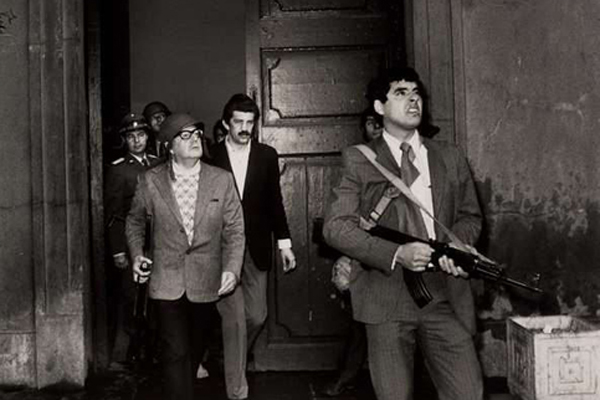
Allen on The Battle of Chile: "a 190-minute chronicle of the death throes of a revolutionary government in its most crucial social context... What sets Patricio Guzman and his collective apart is the enlightenment of their selectivity... It is as if Frederick Wiseman had sprouted six sets of feet for mobility and six sets of eyes for perception."
Chastity notwithstanding, Allen was no puritan. Reviewing Word Is Out, a documentary platform which allows a number of homosexuals from all walks of life to give testimony about their experiences, Allen notes that "One theatrical release in 1978 only begins to atone for a film heritage of virulent propaganda against gays." He was frankly susceptible to the beauty of performers, of Sissy Spacek, "a wisp of freckled, long-stemmed Texan energy with limpid, riveting eyes," and of Nastassia Kinski's "voluptuously flared lips." "He once told me that he had a dream about Kinski coming to him in her underwear with unshaven legs," says Jones. "I thought, ‘Well that was an interesting thing to share.' And I have a memory of the two of us sitting there and laughing ourselves almost to death reading a passage from Viveca Lindfors's autobiography talking about her marriage to Don Siegel, her fond memories of their days together, and her absolute contentment when ‘Don would be on top of me, his penis inside of me.'"
A piercing wit runs through Allen's criticism, particularly when dealing with the truly lunkheaded picture. Part and parcel with his idea that all movies are created equal, Allen doesn't withhold his most imperious, damning prose from an it's-just-a-movie-jape like Andrew V. McLaglen's The Wild Geese, writing that "in its financing and in its import it carries the benediction of the white power structure in southern Africa and of one of its agencies of control, the mercenary network. Every movie about soldiers on a mission—the very word mission implies an ideological partisanship-puts forth a polemic stance." And though an avowed auterist, Allen was also unusually savvy to the role of both studios and producers when it came to assigning praise or—more often—blame. His scrupulous file-keeping meant he knew track records and historical weaknesses as well as any baseball scout-a comparison he flaunted. Reviewing Blue Country: "I knew Jean-Charles Tacchella had a knuckleball; but I'm still not sure he's a winner... Tacchella has had to stay hyped, putting that little extra on each scene, just to keep his mushballs from being slaughtered."
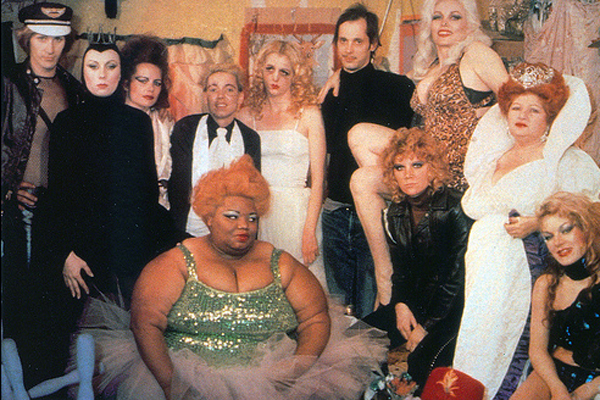
Allen on Desperate Living: "I dare anyone not to take John Waters seriously after Desperate Living... He is a driven, integral stylist. His troupe are beautiful orges because they collaborate in absolute harmony with his ends, and are, therefore, not exploited."
In late 1977, in one of the all-time great draft picks, Hoberman was recruited by Richard Goldstein to be the Voice's third-string critic, covering the avant-garde beat. He recalls the office on University Place as "Tiny... if you were in there, you were literally on top of everyone else who was there." Among a contentious crowd, Allen stuck out. "He was a jolly guy, he would've worked in some kind of Robin Hood-type, medieval movie. He was stocky, had a round face, he was usually smiling, had a happy temperament . . . I never, ever saw him come even close to losing his temper about anything." This wasn't his only distinction: "It literally blew my mind when I found out that he was a monk. I couldn't fathom that. I couldn't really understand what that meant. I guess if you had a job, whatever you made, you just came back and it was shared among the Brothers in the house."
"He would give money to whoever wanted it, but he did it in an extremely unassuming way," says Jones, who was an undergraduate at New York University when he wrote a fan letter to Sarris—and received a reply from Allen. The letter invited Jones to a Voice internship, and he arrived to new offices on Broadway in 1981, knowing Allen only from his criticism. "He wrote like someone who was Andrew's acolyte, but he has a different kind of orientation, and I couldn't quite place it . . . I pictured him as a very thin, dry, ascetic kind of individual, which was partly right and partly wildly incorrect. He looked like Friar Tuck. In fact, George Romero wanted to cast him as Friar Tuck in Knightriders."
Allen had already lost his reviewing slot by the time Jones arrived. As he recalls, the laconic, detail-oriented Allen had been deemed "too boring." Hoberman explains, "There was a kind of putsch in mid-1980... [Editor-in-Chief David Schneiderman] was all set to fire Andy, until Alex Cockburn told him, ‘You can't fire this guy, he's world famous. He was on the short list for a Pulitzer and blah blah blah.' So, they didn't fire Andy, but what they did is they fired Tom and replaced him with Carrie Rickey. I was too unimportant, the scythe went over my head . . . Tom stayed on, I don't know if he was paid or not." "One of the most crushing things that happened is they more or less took Tom away from Andrew," says Haskell, "I don't think he got any money for it, it was more or less a total labor of love." Allen's last outing in the second-string slot came on September 10, 1980.
Throughout his tenure as a beat critic for the Voice and beyond, Allen was also contributing to the Long Island Catholic, a diocesan paper. His work there, and whether his tone changed as his audience did, will be a subject for further research. Allen was also residing with and tithing his income to the Brothers of the Sacred Heart—and living in an area that, after Howard Cosell's famous comment on the telecast of the 1977 World Series, had become a byword for urban blight.
In a review of 1978, Allen notes as an aside: "I was able to look out my window last Sunday night in the South Bronx at two simultaneous fires in the third of my street remaining since I moved in five years ago." From 1974 and 1983 Brother Bill Cawley lived in the same residence as Allen at 138th St between Brown Pl and Alexander Ave, two blocks from where Cawley had grown up. Now semi-retired and living in Metuchen, Cawley remembers that Allen was unfazed by the rough environment: "He never thought anything of coming home in the middle of the night from movies. He had that totally calm demeanor." And despite Allen's grueling schedule, "He really tried to be with us, certainly for morning prayer and for evening meal... He was always able to keep up with our community activities, for example house meetings, and he contributed a lot. But the movies were his passion, and educating others about them was his passion." While Cawley was himself teaching at nearby St. Luke's school, he says that Allen "didn't have it in him to be a teacher and do all the discipline that teaching required." Allen was able to justify his critical writing to the Brotherhood as part of his pedagogical mission, though "He had to stand up for that a number of times."
In the midst of this contemporary Reign of Terror, the Brotherhood relocated to a new residency in East Elmhust, Queens at 71st St & 31st Ave., associated with Monsignor McClancy High School, in 1983. This was during Jones's time at the Voice, and he recalls assisting in the move: "He asked me and another intern, Scott Smith, if we would help him get some stuff out of his house. And he said ‘You'll know the block when you see it. There's nothing to the left of my building, on the right of my building, or across the street. It's a pile of rubble.' And he was right. There was nothing."
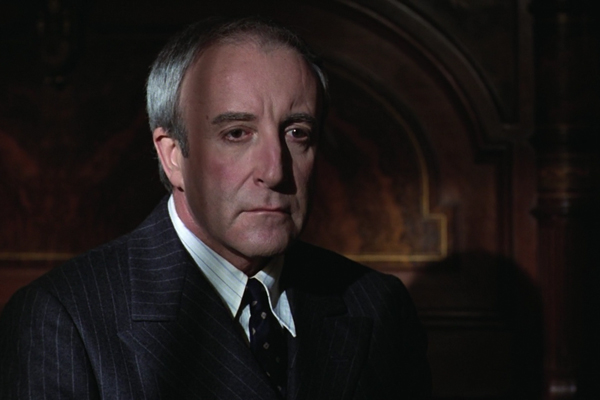
Allen on Being There: "Ashby is America's most talented director when it comes to finding the right visual tone for a wide range of narrative formats. He excels in choosing apt, tightly controlled frames, and his eclectic resourcefulness allows him to navigate Chance past a bravura overflow of video images and through an impressive array of corridors of power."
Jones's internship at the Voice stretched on and evolved through a number of years, during which Allen remained on. With Rickey and later others taking over Allen's old reviewing bailiwick, all that remained was to assist Sarris in various endeavors, including the capsules which made up a section called "Sneak Previews: A Critical Guide to TV on the Movies," covering the movies airing on the networks during a given week. Allen would more and more frequently share this byline with Sarris, though no one doubted his contributions were essential. Says Hoberman, "He used to do these columns which had Andy's name on them, which would be ‘Revivals in Focus' and so on, and he would cut and paste out of Andy's columns and rewrite to do this thing." Jones adds "I had the impression that there was a certain amount of unexpressed resentment, on a very quiet level, on a very low heat, but it was there, and it would be expressed in those capsule reviews. He had been the second-string critic, and then suddenly he wasn't . . . Perhaps Tom felt that Andrew might've done more . . . I think that a lot of the time he would ostensibly be basing the capsule that he wrote on something that Andrew had written, but in fact he really didn't, he would take a sentence or two and, in a lot of cases, diverge wildly from what Andrew had written."
Jones recalls that Allen "held the fort" during Sarris's illness and convalescence of 1984-'85, detailed in Haskell's superlative memoir Love and Other Infectious Diseases. But while continuing to publish in the Long Island Catholic and Film Comment, Allen also had other projects afoot. His lone Voice cover story had been for the April 23, 1979 book, a piece titled "Knight of the Living Dead," timed to precede the New York release of Dawn of the Dead. Allen described the ambitions of the involved personnel to make a next-level independent blockbuster with Dawn, profiling both producer Richard Rubinstein and Romero, a cinema-mad Bronx Catholic raised in the parish of St. Helena's in Parkchester who'd taught himself to make movies with an 8mm Revere purchased by a rich uncle in Scarsdale.
As Hoberman notes in his memoir piece, "The late seventies . . . was a dispiriting moment for American movies." Allen chalked this fact up to the rise of what he called the "corporate movie," with its restrictive structures, and he was agog whenever "genuine cinematic vitality [survived] today's motion-picture packaging in the boardrooms of high finance." Allen's model moviemaking entities worked on a more modest scale. Frequently cited examples include early Walt Disney, Hal Roach Studios, or the American International and New World Pictures run by that "pop genius of exploitation and benign sweatshop promoter of new talent," Roger Corman. (Allen bemoaned New World's decline in the Voice, while he was an early champion of alum Jonathan Demme.) Reading "Knight of the Living Dead," one can see Allen's obvious admiration for the business model of Rubinstein and Romero's conglomerate Laurel Entertainment Inc., which funneled profits from various commercial projects into films like Martin and Dawn, which could then be made with a free hand.
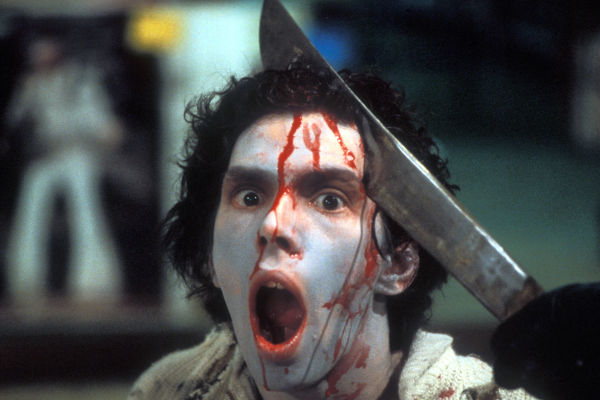
Allen on Dawn of the Dead: "Like James Whale's Bride of Frankenstein, more a tongue-in-cheek variation on an original conception than a sequel... Romero's career hints thorughout of his exploring the filmmaking process as an experiential happening... The mall dictates the open, bright, airy style of the film and informs its rich vein of sociological satire."
Romero, as Allen wrote on the occasion of a 1980 retrospective at the Harold Clurman Theater, was "redefining on his own terms what it means to be a truly independent commercial filmmaker," and Laurel Entertainment looked like a safe bet to become the AIP of the eighties. While Allen had turned down the role of Friar Tuck in Knightriders, he was to assume a real-life role among Romero's Merrie Men. Like Eastwood's Bronco Billy, Romero's quasi-self-portrait Knightriders deals with an itinerant family troupe of show people. The appeal of such narratives or of the common-cause camaraderie in the Disney/ Roach/ Corman/ John Waters/ Malposo/ Laurel workshop-collective model to a man who spent his life in a communal living situation is not difficult to imagine.
"Tom got involved in the whole Romero world," says Jones. "We went with him to the set of Creepshow on the Jersey shore, and we watched the scene where Ted Danson was buried up to his neck in the sand, hung out with George's first wife, and with George. It was like a commune or something, it was a really beautiful time." Presumably Viveca Lindfors, who appears in another of the anthology movie's five segments, was not on set that day.
Creepshow, whose screenplay was written by Stephen King, took its inspiration from William M. Gaines' E.C. comics of the 1950s like Tales from the Crypt, The Haunt of Fear, and The Vault of Horror, in which cruelty, cupidity, vanity, and dishonesty were consistently paid back in ironic just desserts. The film's tidy financial success when released through Warner Bros. in 1982 inspired Romero and Rubinstein to pitch a television show also designed somewhat after the E.C. model. The result was Tales from the Darkside, which premiered on October 29, 1983.
After ten episodes, Romero brought Allen aboard. Allen, whose reviews had consistently cast a keen eye towards flaws in structure and pacing—sometimes to the extent of blinding him to a film's other, obvious virtues—would be variously credited as "script consultant," "story consultant," and "creative consultant" through the remainder of the series' run. He is also credited with cowriting one Darkside teleplay with Howard Smith—presumably the same Howard Smith who'd once had a column for the Voice, and whose films Marjoe and Gadgets Allen had admired. The episode, titled “Snip, Snip,”
ran during the first season, and stars Bud Cort as a schoolteacher who abandons his avocation to dabble in black magic.
A November 1, 1986 article in the South Florida-based Sun-Sentinel, discussing the anomalous success of Darkside among a crowded field of network anthology shows, catches up with one Tom Allen, "a 49-year-old Village Voice film critic and ardent buff." Allen is evidently pleased with the measure of independence that Darkside had won through its success: "There's no standard-and-practices censors, no vice presidents trying to earn their stripes by picking at every little thing," he says. "The show is working, so they let it alone."
Tales from the Darkside ran Saturday nights on CBS for four seasons. It spawned a spinoff movie (Tales from the Darkside: The Movie) and a Laurel Entertainment offshoot series, Monsters, on which Allen was also employed. Throughout this period, Allen continued to proselytize for auteurism at the Voice and to assist Sarris. Taking questions from the audience after a lecture at the University of Washington in March, 1987, Sarris spoke of his future plans: "With Tom Allen, I'm going to combine The American Cinema with ‘Revivals in Focus,' with new categories, new considerations, new alignments, and bring all the new people into the picture. That'll be the next project after The American Sound Film, so that's still a couple of years off."
It was not to be. One of Jones's most vivid memories of Allen is his "Extra-long Mores, constantly. He chain-smoked extra-long Mores. I'm sure that and his weight put him in an early grave." Brother Murphy remembers Allen's infamous junk food diet. Hoberman recalls him suffering an illness at one point, and visiting him during a hospital stay in the Bronx. "He was always on the go," says Brother Cawley, "If there's any fault he had, it was taking care of his health."
One day in 1988, quite without warning, Tom Allen died. Cawley was called into Allen's room when he failed to emerge for morning prayer. Brother Allen had died overnight. It was "A much smaller room than he had in the Bronx," says Cawley, "Things were piled on top of each other, index cards were stuffed in file cabinets." Jones still had a message from Allen on his answering machine when he read the obituary in the Voice. Hoberman sorted through Allen's personal effects in the office, his files and his books, including Ado Kyrou's monogram on Luis Buñuel, which he kept. "It was from the Bishop Reilly library," Hoberman remembers, "I guess he took it out and never returned it."
Alongside Brothers from faraway Kenya and France, Tom Allen is buried in the Brothers Cemetery in Metuchen, New Jersey, a quiet plot behind the House of Studies, nestled between St. Joseph's practice fields. I can find no picture of him online. Jones could only say for certain that Allen had predeceased his mother. Haskell says he left behind family in Queens. Murphy recalls that Allen's older brother, Sonny, was a professional bowler. Obviously, Allen left no children, and his early death gave him little opportunity to cement a legacy. He left copious clippings behind, but no book. Moreover, much of his life's work is inextricably commingled with Sarris's. But considerations of public recognition and ego-stroking were apparently not high among Allen's priorities, for everything in his background had taught him to work for the commonweal.
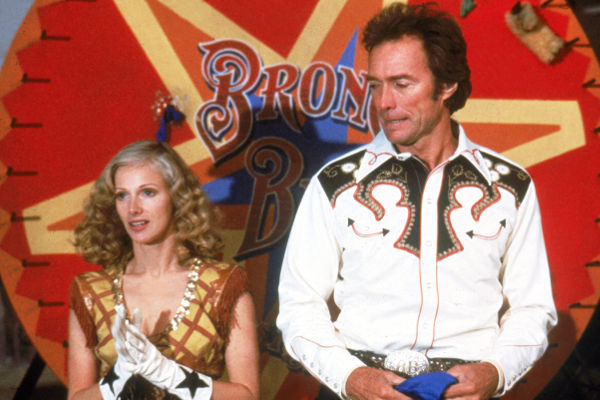
Allen on Bronco Billy: "Billy has a dream... He has sold this dream to a band of hardy disciples... The camraderie of these ensemble dreamers with feet of clay is crucial to how the film works... The wonderful thing about the movie is that he can make you believe the dream despite the reality... Few, besides Gary Cooper, have dared suggest an heroic figure might be slow in the head."
"He was a very self-effacing guy," says Jones. "Everything he did was in service: His writing for the Voice was in service of auteurism, as his writing for the Long Island Catholic would've been in service of the faith." Haskell also uses the phrase "self-effacing." "He preferred it that way," she says, "he didn't want to be known particularly, he wasn't after a legacy or anything like that. I just remember a tremendous personal warmth and a willingness to do this sort of dogged work. And he was so cheerful! Everybody was always in a foul mood about politics or this or that. Tom was unfazed by it all. In some sense he was the purest of all devotees, because it was uncomplicated by ambition or politics—not that those aren't interesting aspects of a film critical sensibility—but there really was something pure about this devotion." Hoberman notes the impact that Allen had in a relatively short stint as a beat critic: "People tend to forget that somebody had to discover these things. There had to be someone there to talk about Halloween seriously."
Today, Tom Allen has assumed a marginal place in the story of film criticism and history, though he has not been forgotten by those who knew him. Without exception, everyone that I contacted in the course of writing this article said some variation of "I think it's great that you're writing something about Tom," and each of them had a half-dozen names to recommend of people who would know something more. Hopefully, in time, this piece can expand to include their testimonies. The lone exception was John Carpenter, who declined to be interviewed because, per his assistant, "He doesn't really know anything about Tom Allen."
Reading what's available of Allen's corpus, one encounters a distinct, demotic perspective on cinema—perhaps more distinct from his model Sarris's perspective than he recognized. This vision came without the sense of self-promotion and self-preservation that might've put it across to a broader audience. There are those who are gifted in their craft and those who are skilled in, to paraphrase Voice cofounder Norman Mailer, writing Advertisements for Themselves. Sometimes these gifts coalesce in one person, and the result is a brilliant career—like Sarris's, like Romero's and Carpenter's—but even these need the help of facilitators or great well-wishers like Tom Allen.
Allen also aided careers which had barely begun. "My experience with Tom Allen," says Chin, "was one of the defining experiences of my professional life." "I'd had my share of people who were blindly encouraging up to that point," Jones says. "Tom could be very enigmatic as a mentor, and this was very helpful. Having a conversation and taking it only so far and leaving you to puzzle out your own." Rather than ending on an inappropriately grandiose note, casting Allen as an Assisi of the grindhouse or a major minor critic whose time has come, better to simply say that he fulfilled his mission: To do good works for cinema. Bless him for it.
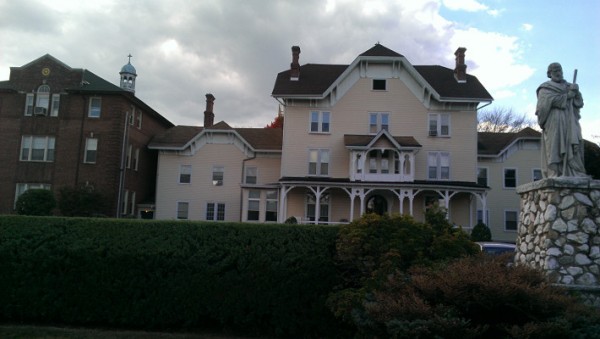
St. Joseph's House of Studies in Metuchen, New Jersey. Statue of St. Francis in foreground. The monk of the 21st century favors a Toyota, either the Camry or Corolla.
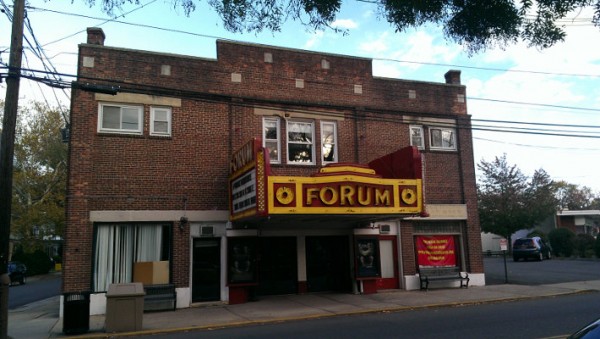
The Forum Theatre in Metuchen, New Jerse ![]()
LATEST ARTICLES
-20140814-173707-thumb3.jpg)
Fighting Words
by Imogen Sara Smith
posted August 12, 2014

Fighting Words, Part 2
by Imogen Sara Smith
posted August 20, 2014

On the Margins: The Fil…
by Andrew Chan
posted August 12, 2014

Robin Williams: A Sense…
by David Schwartz
posted August 12, 2014
 The Movie Monk
The Movie Monk
THE AUTHOR
Nick Pinkerton has written about films in The Village Voice, Reverse Shot, and Stop Smiling magazine. He is a product of Cincinnati, Ohio, and currently lives in Brooklyn, New York.
More articles by Nick Pinkerton
